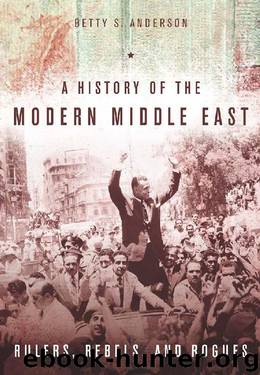A History of the Modern Middle East: Rulers, Rebels, and Rogues by Betty Anderson

Author:Betty Anderson [Anderson, Betty]
Language: eng
Format: epub
Publisher: Stanford University Press
Published: 2016-04-19T21:00:00+00:00
FIGURE 6.5. The Western Wall and Dome of the Rock on the Haram al-Sharif as seen from the Jewish quarter of the Old City of Jerusalem. The Moroccan quarter fills the area in front of the Western Wall.
Palestinian Revolts of the 1930s
The conflicting Jewish and Palestinian national desires for Palestine and the separate institution building they had undertaken caused sustained conflict beginning in 1929. The first revolt began when conflicts over Jewish prayer space at the Western Wall, or Wailing Wall, in Jerusalem erupted into fighting across the mandate, resulting in the deaths of more than 200 Palestinians and Jews. The British had followed Ottoman policies when taking over any contentious religious sites; in this case the Jews had very little access to the Western Wall of the Jewish Temple destroyed in AD 70 by the Romans. Efforts by Jewish men and women in the late 1920s to expand the site in front of the wall led to clashes with Palestinians trying to keep them from changing the religious arrangements.
. . .
OLD CITY OF JERUSALEM
The Old City of Jerusalem is a 4,000-year-old city that currently encompasses one square kilometer, surrounded on all sides by walls built in the 16th century by Ottoman Sultan Süleyman the Magnificent. The Romans, who ruled the city between 63 BC and AD 324, erected two roads bisecting the city east to west and north to south. Nineteenth-century maps designate the four quadrants separated by these roads as the Muslim, Christian, Armenian, and Jewish quarters, but this clear-cut delineation between religious groups does not represent the reality of life in the Old City when the maps were produced or even for decades thereafter. Census records indicate that no quarter was exclusive to only one religious group. For example, in the last years of the Ottoman Empire, only about 60 percent of the city’s Muslims lived in the Muslim quarter, with the remaining families housed in the other three quarters.
The designations do coincide with holy sites important to the city’s Muslims and Christians. The Muslim quarter includes the Haram al-Sharif (Noble Sanctuary) with the Dome of the Rock and the al-Aqsa Mosque; the Christian quarter, the Holy Sepulchre; and the Armenian quarter, the convent of St. James and the residence of the Armenian patriarch for Jerusalem. The Jewish quarter does not encompass the Western Wall, the holiest Jewish site in the city, because the Muslim empires prohibited Jews from building homes in the area. Instead, the Jewish quarter overlooks the Western Wall and includes within its zone synagogues and Jewish housing existing from at least the 13th century.
Situated between the Jewish quarter and the Western Wall was the Maghribi, or North African, neighborhood, built as a waqf endowment for North African Muslims in the aftermath of the Muslim expulsion of the Crusaders in the 12th century. Over succeeding centuries, additional endowments expanded the area, and the Ottomans invited Muslims expelled from Spain in the 15th century to live in it. Houses were built just a few feet
Download
This site does not store any files on its server. We only index and link to content provided by other sites. Please contact the content providers to delete copyright contents if any and email us, we'll remove relevant links or contents immediately.
| Africa | Americas |
| Arctic & Antarctica | Asia |
| Australia & Oceania | Europe |
| Middle East | Russia |
| United States | World |
| Ancient Civilizations | Military |
| Historical Study & Educational Resources |
Empire of the Sikhs by Patwant Singh(22767)
The Wind in My Hair by Masih Alinejad(4843)
The Templars by Dan Jones(4558)
Rise and Kill First by Ronen Bergman(4545)
The Rape of Nanking by Iris Chang(4023)
12 Strong by Doug Stanton(3419)
Blood and Sand by Alex Von Tunzelmann(3056)
The History of Jihad: From Muhammad to ISIS by Spencer Robert(2506)
Babylon's Ark by Lawrence Anthony(2432)
The Turkish Psychedelic Explosion by Daniel Spicer(2245)
Gideon's Spies: The Secret History of the Mossad by Gordon Thomas(2236)
No Room for Small Dreams by Shimon Peres(2236)
Inside the Middle East by Avi Melamed(2230)
Arabs by Eugene Rogan(2193)
The First Muslim The Story of Muhammad by Lesley Hazleton(2154)
Bus on Jaffa Road by Mike Kelly(2035)
Come, Tell Me How You Live by Mallowan Agatha Christie(2027)
Kabul 1841-42: Battle Story by Edmund Yorke(1921)
1453 by Roger Crowley(1880)
